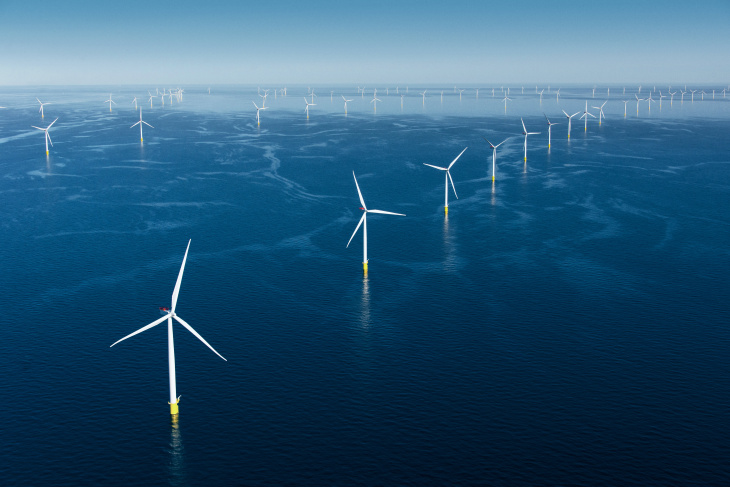Larger than expected
The foundation of offshore wind turbines have a larger impact on the marine environment than previously thought. They change the mixing of the water far beyond their own location, as model simulations by researchers at the Helmholtz-Zentrum Hereon have now shown. Their results were published in the scientific journal Frontiers.
Offshore wind turbines extract energy from the wind and thus influence the wind speed at the sea surface. This has implications for the mixing of the water as well as its current speed. These are well-known effects that are traced back to the wind turbines. However, the piles of the wind turbines also influence the marine environment far beyond their own location, as Hereon researchers have now shown with regional ocean models.

Flow patterns at an offshore wind farm off the coast of Denmark. Photo: Ørsted
For their studies, the researchers at the Hereon Institute of Coastal Systems - Analysis and Modeling focused on so-called monopile foundations. This commonly used type of pile has a diameter of six to eight metres and weighs 750 tonnes - about as much as 600 small cars. They therefore pose a great resistance to the ocean current and thus disrupt the natural flow of the water. As a result, they cause turbulence that changes the mixing of the water, meaning the distribution of temperature and salts between the surface and bottom layers. This can in turn affect the distribution of nutrients between the water layers and thus primary production.
Another effect of the turbulence is a reduced current speed downstream, that is, in the direction of the tidal current, which is decisive for sediment transport. At ten per cent, the changes caused this way are still in the same range as annual fluctuations that occur naturally in ocean dynamics.

Post-processed satellite images of turbulent sediment plumes downstream of offshore wind turbines near the UK coast. Photo: NASA Earth Observatory / Jesse Allen
"We see that the impacts of local turbulence effects extend far beyond the boundaries of the wind farms. Now we need to find out how these effects interact with the impacts of wind decrease and what consequences this entails for the ecosystem," says Nils Christiansen, lead author of the study and scientist at the Hereon Institute of Coastal Systems - Analysis and Modeling.
The fact that these impacts are not limited to the direct surroundings of the wind farms, but affect large areas beyond, is particularly relevant for assessing the effectiveness of marine protected areas in the German Bight. Even if protected areas are not directly adjacent to wind farms, they can still be affected by them. These results should therefore be taken into account in the rapidly advancing expansion of offshore wind power. Instead of assuming that areas outside wind farms remain completely unaffected, it should rather be determined whether and how far wind farms need to be from protected areas. Because their influence does not necessarily have to be negative - which in turn shows: The energy transformation can only be sustainable in combination with environmental protection.
Further information
- Original publication Christiansen, N., Carpenter, J.R., Daewel, U., Suzuki, N., Schrum, C. (2023) The large-scale impact of anthropogenic mixing by offshore wind turbine foundations in the shallow North Sea. Front. Mar. Sci. Volume 10. https://doi.org/10.3389/fmars.2023.1178330
- Institute of Coastal Systems - Analysis and Modeling
Contact
Scientist
Institute of Coastal Systems - Analysis and Modeling
Phone: +49 (0) 4152 87-2132
